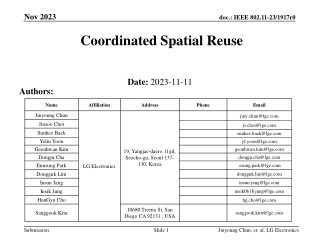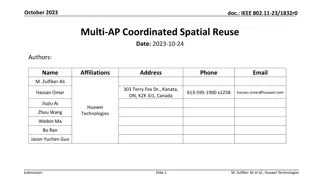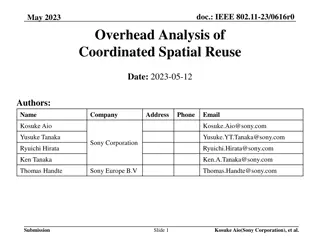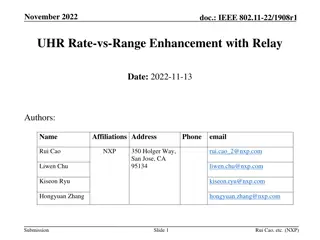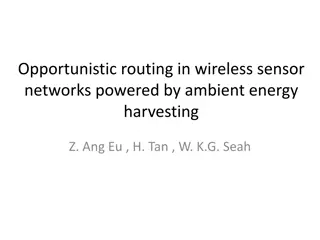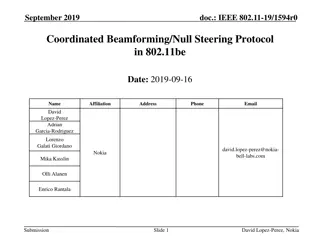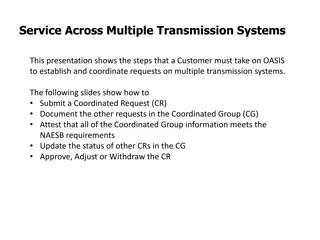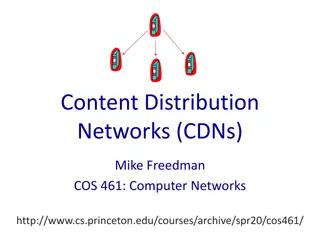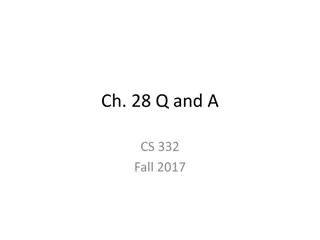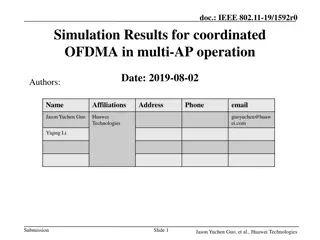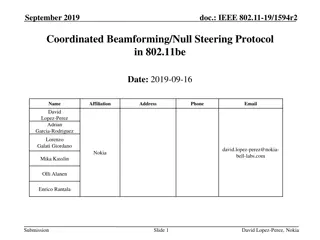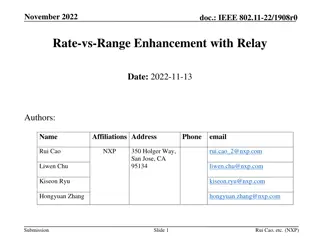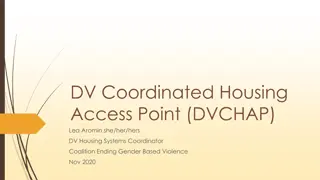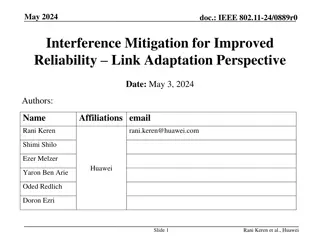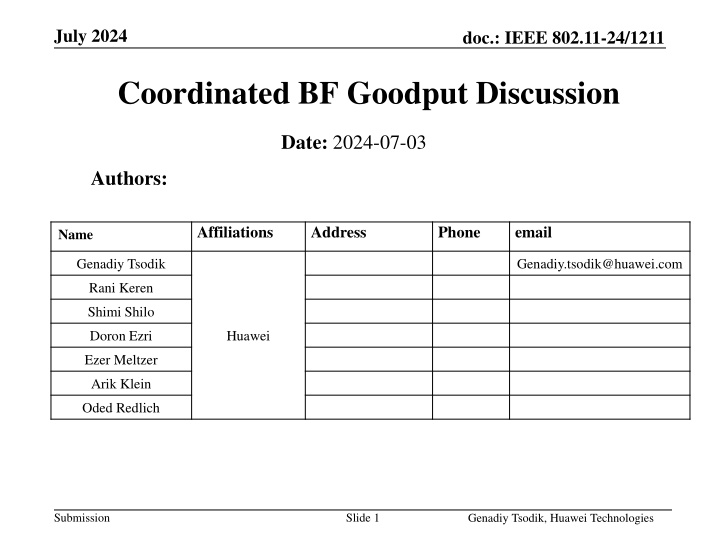
IEEE 802.11-24/1211 Coordinated Beamforming Goodput Analysis
Explore the study on Coordinated Beamforming (CoBF) in IEEE 802.11 standards, comparing its performance with DL MU-MIMO. The simulation results reveal a significant gain in goodput with CoBF due to its enhanced Tx antenna utilization. Dive into the timeline diagram and insightful discussions on the potential benefits of adopting CoBF for improved wireless communication efficiency.
Download Presentation

Please find below an Image/Link to download the presentation.
The content on the website is provided AS IS for your information and personal use only. It may not be sold, licensed, or shared on other websites without obtaining consent from the author. If you encounter any issues during the download, it is possible that the publisher has removed the file from their server.
You are allowed to download the files provided on this website for personal or commercial use, subject to the condition that they are used lawfully. All files are the property of their respective owners.
The content on the website is provided AS IS for your information and personal use only. It may not be sold, licensed, or shared on other websites without obtaining consent from the author.
E N D
Presentation Transcript
July 2024 doc.: IEEE 802.11-24/1211 Coordinated BF Goodput Discussion Date: 2024-07-03 Authors: Affiliations Address Phone email Name Genadiy Tsodik Genadiy.tsodik@huawei.com Rani Keren Shimi Shilo Doron Ezri Huawei Ezer Meltzer Arik Klein Oded Redlich Submission Slide 1 Genadiy Tsodik, Huawei Technologies
July 2024 doc.: IEEE 802.11-24/1211 Recap Coordinated BF was accepted in 802.11be as one of the M-AP Cooperation schemes (was postponed to R2) and is considered now for 802.11bn as well Several contributions discussed the principles of the CoBF scheme and introduced some analysis of PHY requirements and beamforming principles [1]-[4] In [5] we showed the nulling principles and explained the changes that should be applied to a classical SVD based precoder to ensure zero MUI in case of CoBF In this contribution we want to compare the CoBF scheme to regular DL MU-MIMO as well as CoSR, and study the potential gain of CoBF Submission Slide 2 Genadiy Tsodik, Huawei Technologies
July 2024 doc.: IEEE 802.11-24/1211 CoBF vs MU-MIMO Simulation We ran the simulation with the following parameters: 2 APs, 4 Tx Antennas each STA1 AP1 4 STA, 2 Rx Antennas (each AP is associated with 2 STAs) STA2 Operation schemes: CoBF, DL MU-MIMO 20MHz BW, Channel D, practical CHEST STA3 Modulation: MCS3 MCS8 AP2 Nss in CoBF: 1SS per STA, Nss in DL MU-MIMO: 2SS per STA STA4 Sounding: Joint NDP (see next slide) Payload Size: 50KB, 200KB Submission Slide 3 Genadiy Tsodik, Huawei Technologies
July 2024 doc.: IEEE 802.11-24/1211 CoBF Timeline Diagram To calculate the overhead and provide the goodput results, we assume that CoBF scheme uses Joint NDP Sounding APs jointly transmit NDP to STAs associated with specific AP Thus the timeline assumed for goodput calculations of CoBF is as depicted below MAP TF NDP NDPA BFRP MAP TF AP1 MAP TF CoBF Data NDP NDPA CoBF Data MAP TF AP2 NDP NDPA NDP CoBF Data NDPA BFRP CoBF Data BFR STA1 BFR STA2 STA3 BFR BFR STA4 Submission Slide 4 Genadiy Tsodik, Huawei Technologies
July 2024 doc.: IEEE 802.11-24/1211 Goodput Results The goodput results of CoBF and DL MU-MIMO are showed in the figure below The gain of ~5-6dB of CoBF may be observed along all the SNR values due to larger (effective) number of Tx antennas used in the CoBF scheme Submission Slide 5 Genadiy Tsodik, Huawei Technologies
July 2024 doc.: IEEE 802.11-24/1211 Comparison to CoSR We assume a very simple CoSR protocol with minimal information exchange between Sharing and Shared AP the only indication is the power requirements provided by the Sharing AP when CoSR is triggered This assumption implies the following principles: Only Shared (OBSS) AP is mandated to control its power according to Sharing AP indication Interference is not synchronized (OBSS packet start is random in simulation - up to half of the PPDU duration) For simplicity, symmetry is assumed same SIR at BSS and OBSS receiver We assume that each STA measures the signal RSSI from OBSS AP and reports it to its AP, so APs can carry out a better selection of STAs that participate in CoSR transmission Submission Slide 6 Genadiy Tsodik, Huawei Technologies
July 2024 doc.: IEEE 802.11-24/1211 CoBF vs CoSR Simulation We ran the simulation with the following parameters: 2 APs, 2 Tx Antennas each STA1 AP1 2 STA, 2 Rx Antennas (each AP is associated with 1 STA) Operation schemes: CoBF, CoSR 20MHz BW, Channel D, practical CHEST Modulation: MCS3 MCS8 AP2 STA2 CoBF: 1SS per STA, CoSR: 1 or 2 SS per STA CoBF Sounding: Joint NDP - same overhead as in previous comparison Payload Size: 200KB Submission Slide 7 Genadiy Tsodik, Huawei Technologies
July 2024 doc.: IEEE 802.11-24/1211 Goodput Results 1SS per STA The goodput results of CoBF and CoSR with 1SS per STA are showed in the figure below When noise is dominant similar goodput is observed for CoBF and CoSR, whereas when interference is dominant CoBF achieves a higher goodput Submission Slide 8 Genadiy Tsodik, Huawei Technologies
July 2024 doc.: IEEE 802.11-24/1211 Goodput Results 2SS per STA in CoSR The goodput results of CoBF and CoSR are showed in the figure below We compare to CoBF with 1SS per STA because CoBF is DoF limited (due to MUI nulling) When SNR and SIR are high CoSR achieves higher goodput due to larger number of spatial streams, whereas at low SNR values CoBF shows better performance Submission Slide 9 Genadiy Tsodik, Huawei Technologies
July 2024 doc.: IEEE 802.11-24/1211 Conclusions CoBF provides a clear & constant gain over MU-MIMO, mostly due to array gain Both CoBF and CoSR are valid schemes with clear benefits, for which the results depend on transmission parameters and channel conditions: CoBF significantly outperforms CoSR when the same number of spatial streams is used in both schemes (for all SNR and SIR values) In specific scenarios (higher value of Nss, high SNR and SIR) CoSR yields higher goodput We may consider both CoSR and CoBF as candidate MAP schemes; the relevant scheme may be selected for operation based on channel conditions Submission Slide 10 Genadiy Tsodik, Huawei Technologies
July 2024 doc.: IEEE 802.11-24/1211 Straw Poll #1 Do you agree to add the following text to the TGbn SFD: TGbn shall define Coordinated Beamforming (CBF) and Coordinated Spatial Reuse (CSR), which allow concurrent transmissions of at least two PPDUs from at least two BSSes on the same channel. Y N A Submission Slide 11 Genadiy Tsodik, Huawei Technologies
July 2024 doc.: IEEE 802.11-24/1211 References [1] 11-24-0011-00-00bn-coordinated-spatial-nulling-c-sn-concept [2] 11-24-0012-00-00bn-coordinated-spatial-nulling-c-sn-simulations [3] 11-24-0009-01-00bn-coordinated-beamforming-coordinated-beamforming- for-802-11bn [4] 11-23-0776-01-0uhr-performance-of-c-bf-and-c-sr [5] 11-23-1998-00-00bn-zero-mui-coordinated-bf Submission Slide 12 Genadiy Tsodik, Huawei Technologies

